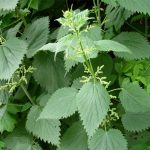The Learning Homestead
Have you ever heard of Plantain? No, not the banana looking things that are delicious fried with sugar added. There is a plant that grows virtually everywhere called Broad Leaf Plantain. Practically everyone has seen it, and the majority presume it to be a weed. We did too for a long time. It is, in fact, an amazing medicinal plant that is free for the taking. It can be used to treat everything from insect stings and bites to minor cuts and scrapes. Below is a step-by-step guide to making your own Plantain Salve with pictures of each step:
Plantain Salve images








- Plantain Leaves
- Carrier oil (fractionated coconut, olive or similar oil)
- Dehydrator (optional)
- Blender (optional)
- Oven or dehydrator
- Fine mesh strainer and/or cheese cloth
- Stainless steel saucepan
- Stovetop
- Essential oils (optional)
- Suitable container for salve
You may also add essential oils to your salve after removing it from the heat and before it begins to solidify. Many essential oils smell good, and have healing properties of their own. Mrs. TLH is a dōTERRA consultant, and we added 30 drops each of lavender, melaleuca (tea tree), and frankincense to our salve.
Beginning with two and a half (2.5) ounces of dehydrated Plantain leaves, two and a half (2.5) cups of fractionated coconut oil, and two and a half (2.5) ounces of beeswax, we wound up with one and a half (1.5) pints or six 1/4 pint jars of salve.
The total time for this project was about 14 hours, but only about 1 working hour.
1. Harvest some Plantain. There’s no magic to it. It grows everywhere and is easily recognizable. Just pick or cut as much as you think you need.
2. Rinse and dry the leaves.
3. Dehydrate the leaves. This can be done as simply as placing them on some old window screening in a well ventilated spot out of direct sunlight. For expediency, we used our 10 tray Excalibur dehydrator.
4. Once the leaves are fully dehydrated (they should crumble just like very dry fall leaves when handled), crush them into very fine pieces. We did this by crumbling them into a blender and then pulsing a few times.
5. Carefully weigh the Plantain leaves in ounces.
6. Add one (1) cup of fixed carrier oil per ounce of dehydrated Plantain leaves. We used a food grade fractionated coconut oil, but olive oil will work okay, too.
7. Once you have stirred in your oil, put it in the oven on the lowest possible setting or, if you’re using a programmable dehydrator, 120° for about 4 hours. This will allow the active ingredients in the Plantain to fully leech into the carrier oil, making an infusion.
8. Strain all leaf particles from the infused oil. We used a fine wire mesh strainer topped with a few layers of cheese cloth.
9. Pour the infusion into a stainless steel pot and heat over medium-low heat on the stove top. Add in one (1) ounce of beeswax for every ounce of dehydrated Plantain leaves. We used organic beeswax pellets, but you could grate some off of a bar. Reserve a small amount of both wax and infusion to one side. We would recommend that you use a “cosmetic grade” and not a “candle grade” beeswax. The cosmetic grade has fewer impurities.
10. After the infusion and wax have emulsified, spoon out a small amount and chill it in your freezer for 2-3 minutes before removing the remaining mixture from the heat. Once your sample has solidified, test the consistency to ensure that you can easily spread it with a finger.
11. If the consistency of the cooled salve is to your liking, simply divide into containers and allow it to cool at room temperature. We packaged ours in Ball 1/4 pint quilted preserve jars.
Article from the Off Grid and Homestead Homeopathy and Healing Facebook Group and written by Shaun O’Neal






